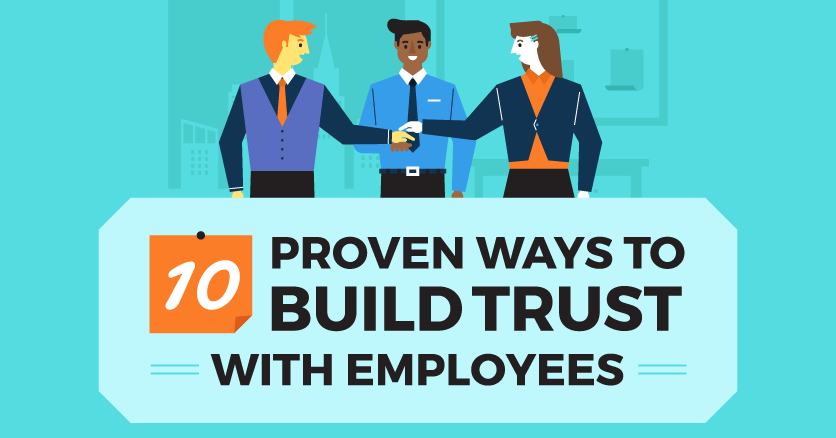10 Proven Ways to Build Trust With Employees
Technology is such a big part of business these days that it’s easy to forget what really powers your workplace: people. A loyal, dedicated team produces better results than a stressed or disengaged workforce. And at the heart of this dynamic is trust.
In fact, a business with high levels of trust is 2½ times more likely to have high revenues than one where trust is an issue. Sure, ruling through fear gets things done, but employees will do the bare minimum amount of work needed to keep their jobs.
Smart leaders know that engaged workers bring creativity and passion to their work, which means more minds seeking more solutions to everyday problems. Building trust takes time, and while it should come from the heart there are specific professional techniques you can use to make it happen.
Becoming known as somebody who listens is a good start: when you listen, you show your employees that you regard them as more than just pieces on your own personal chessboard. Listening is the start of empathy, and a team that understands each other is a team that can solve problems together. Henry Ford rated the ability to see things from the other person’s point of view as one of the greatest secrets of success.
But a leader should also learn to let down their own guard. In the 21st-century leadership means narrowing the distance between yourself and others, not putting yourself on a pedestal. Hold regular ice-breaking sessions. Social events will actually stimulate the release of oxytocin in the brain, which is a trigger for ‘collective action.’
We’ve created a guide outlining proven ways managers can build trust in the workplace. Choose the ones that work for you, and introduce them into your daily routine. Through the days and weeks you will feel your team begin to bond, and see the results in your productivity and revenue.
Ernest Hemingway once wrote, “The way to make people trust-worthy is to trust them.” Demonstrate your faith in your employees and they will repay you with their dedication.

Sources
- Lencioni, P. (2015). Why Great Leadership Fuels Innovation. inc.com
- Ultimate Software. (2017). Uncovering the Positive Drivers of Employee Experience. ultimatesoftware.com
- Interaction Associates. (2014). Building Workplace Trust. interactionassociates.com
- Zak, Paul J. (2017). The Neuroscience of Trust. hbr.org
- Reina, D. (2018). 4 Questions to Build Trust and Have Your Expectations Met. reinatrustbuilding.com
- Riordan, Christian M. (2014). Three Ways Leaders Can Listen with More Empathy. hbr.org
- Kramer, Roderick. M. (2009). Rethinking Trust. hbr.org
- Mind Tools. (2018). How to Have a Great One-on-One. mindtools.com
- The Table Group. (2018). The Five Dysfunctions of a Team. tablegroup.com
- Hurley, Robert. F. (2006). The Decision to Trust. hbr.org
- Burchard, Brendon. (2018). How to Stick to Your Word (Integrity!). brendon.com
- Zak, Paul J. Barraza, Jorge, A. (2013). The neurobiology of collective action. ncbi.nlm.nih.gov
- EOS Worldwide. (2018). Your biggest strengths could be your ultimate weakness. blog.eosworldwide.com
Hemingway, E. (1953). Ernest Hemingway Selected Letters. books.google.fr
Embed This Image On Your Site (copy code below):





